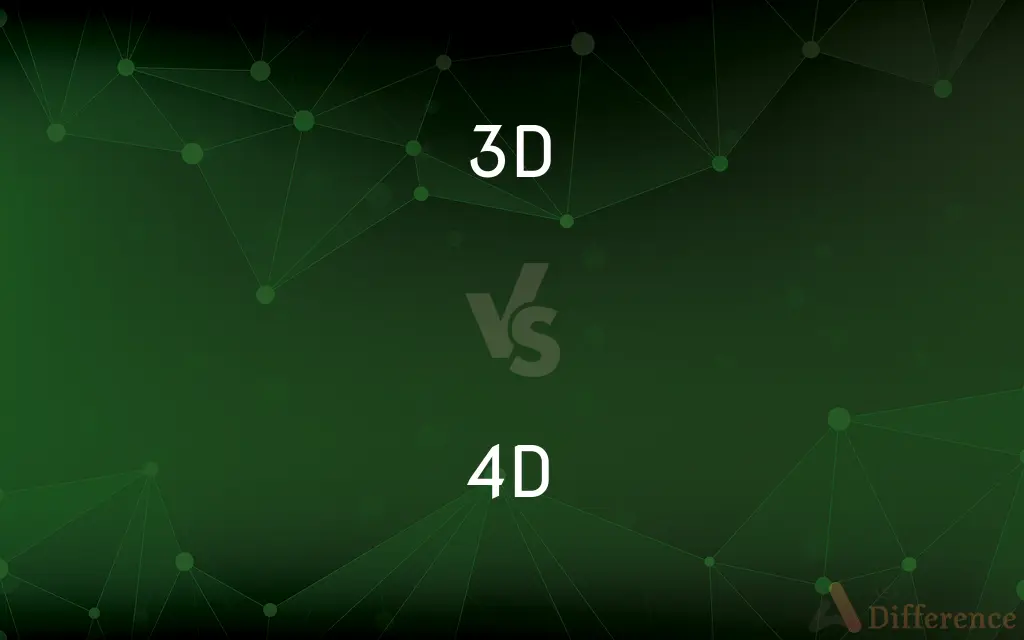3D vs. 4D — What's the Difference?
By Tayyaba Rehman — Published on November 11, 2023
3D represents three-dimensional space, providing depth perception, while 4D adds time as an additional dimension, often with physical experiences or movement.

Difference Between 3D and 4D
Table of Contents
ADVERTISEMENT
Key Differences
"3D" stands for three-dimensional, referring to objects or images that have width, height, and depth. The term is heavily used in contexts like 3D modeling, cinema, and printing. "4D," on the other hand, refers to four-dimensional space, the fourth dimension generally being recognized as time, used in 4D films or theoretical physics.
3D technology has revolutionized industries by allowing for the creation of lifelike representations of objects, providing an immersive experience that flat, two-dimensional (2D) images cannot. 4D expands on this by incorporating time or motion, often including tangible experiences like scent or tactile changes, creating an even more immersive experience.
3D content is experienced through stereoscopic glasses in movies or by manipulating digital objects in software. It's pivotal in areas like medicine, architecture, and entertainment. 4D experiences, however, combine 3D visual content with physical effects that occur in synchronization with the visual media.
In a 3D movie, viewers would see images with realistic depth and contours. In contrast, a 4D film might include chair movements, water sprays, or smell, aligning these physical effects with the events of the movie, providing a multi-sensory experience.
While 3D technology focuses on visual realism, 4D technology aims to engage additional senses, creating comprehensive sensory experiences. This makes 4D particularly popular in theme parks and interactive installations.
ADVERTISEMENT
Comparison Chart
Dimensions
Three (spatial)
Four (three spatial, one temporal or experiential)
Usage
Movies, images, modeling
Interactive experiences, certain films
User Experience
Visual depth
Sensory and temporal engagement
Applications
Cinema, gaming, medicine
Theme parks, experimental cinema
Technology
Stereoscopy, computer graphics
Physical effects synchronized with 3D visuals
Compare with Definitions
3D
Depth perception in film
The 3D movie made the characters seem like they were jumping out of the screen.
4D
Time as the fourth dimension
In 4D space-time models, time is considered alongside traditional spatial dimensions.
3D
Three-dimensional printing
With a 3D printer, we can create actual models from our digital designs.
4D
Cinema with physical effects
The 4D theater experience simulated rain and wind during the movie.
3D
Spatial representation
The architects showcased the project through a 3D model.
4D
Interactive installations
The 4D art installation lets participants experience different temperatures and smells as they walk through.
3D
Three-dimensional.
4D
Advanced simulations
4D simulations allow scientists to study events over time and space.
3D
A three-dimensional medium, display, or performance, especially a cinematic or graphic medium in three dimensions
They shot the movie in 3D.
4D
Physical experiences in shows
The 4D show included seat vibrations synchronized with the action scenes.
3D
Abbreviation of three-dimensional
3D
Thruppence, threepence, a coin valuing three pennies
3D
A movie with images having three dimensional form or appearance
3D
Having a three-dimensional form or appearance;
Aren't dreams always in 3-D?
3D
Virtual reality environments
3D environments in VR games are incredibly immersive.
3D
Graphical rendering
Artists use 3D rendering to bring their creations to life in videogames.
Common Curiosities
Is 4D technology just for entertainment?
While popular in entertainment, it's also used in scientific simulations and installations.
Do I always need glasses to see 3D images?
Most of the time, special glasses are required to properly perceive 3D visuals, especially in cinemas.
How does 3D technology affect modern design?
It allows for precise modeling and realistic visualization before physical production.
Are 4D experiences accessible everywhere?
They're more common in specialized venues like theme parks, certain cinemas, and exhibitions.
Does 4D cinema make you feel like you're part of the movie?
It aims to, by engaging multiple senses through synchronized physical effects.
What’s the “D” in 4D stand for?
It stands for "dimension," with the fourth typically being time or physical effects.
Can 3D technology create tactile objects?
Yes, 3D printing allows the creation of physical, three-dimensional objects from digital designs.
Is all animation 3D?
No, animation can be 2D (flat images) or 3D (with depth and space), depending on the style.
Are 3D images actual physical objects?
Not on screens, but 3D printing can create tangible objects from digital models.
Is 4D real science or just a term for movie effects?
It's both: a scientific concept in physics and a term for immersive entertainment technology.
Can I create 3D content on a regular computer?
Yes, with the right software, you can create and view 3D models and environments.
Can 3D technology be used in medicine?
Yes, for detailed visualizations of body parts and creating prosthetics through 3D printing.
Is 3D viewing safe for everyone?
Most people can enjoy 3D safely, but it may cause discomfort for some, especially over extended periods.
Are 4D effects the same everywhere?
No, they vary based on the technology used and the experience being created.
What's an example of a 4D experience outside of movies?
Theme park rides often use 4D technology for a more immersive experience.
Share Your Discovery

Previous Comparison
Organic Compounds vs. Inorganic Compounds
Next Comparison
Cartridges vs. TonersAuthor Spotlight
Written by
Tayyaba RehmanTayyaba Rehman is a distinguished writer, currently serving as a primary contributor to askdifference.com. As a researcher in semantics and etymology, Tayyaba's passion for the complexity of languages and their distinctions has found a perfect home on the platform. Tayyaba delves into the intricacies of language, distinguishing between commonly confused words and phrases, thereby providing clarity for readers worldwide.












































